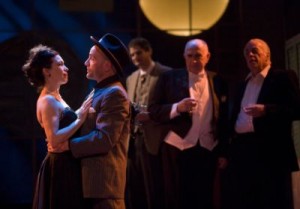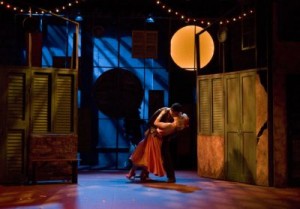
Director Geoff Elliott re-envisions Shakespeare’s The Taming Of The Shrew as a 1950s movie set in Italy and succeeds at the challenge with flying colors, making A Noise Within’s production a veritable treat for Shakespeare lovers and classic film buffs alike.
Purists who take umbrage at “director’s concept” productions of the Bard may well prefer the equally fine (and more traditionally staged) version now playing simultaneously at the Odyssey. More adventurous souls, or those who recoil at the thought of “yet another Shrew,” or simply anyone in the mood for some darned fine theater, will likely fall under the spell of this Taming Of The Shrew as seen through the lens that shot 1953’s Roman Holiday (but in glorious living color).
The scene is quickly and effectively set by sound designer Patrick Hotchkiss with a medley of sounds and songs from 1950s Italian radio programs morphing into Dean Martin’s “That’s Amore.” The cast of characters, exquisitely costumed by Soojin Lee using lots of scarves, hats, and caps, emerge, crossing paths briskly on Kurt Boetcher’s gorgeously-hued set which captures the feel of 50s Padua with its multicolored window shutters in various sizes and shapes.
Leading characters in this Taming Of The Shrew quickly bring to mind film stars of the era—Allegra Fulton’s Katherine as played by a butch Joan Crawford, Jane Noseworthy’s virginal Bianca (think Doris Day in her Warner Brothers days), Antonie Knoppers’ matinee idol-handsome Lucentio (Farley Granger circa Strangers On A Train), and Steve Weingartner’s tough guy Petruchio (James Cagney in prize fighter mode).
Weingartner’s Petruchio, like Cagney, is short of stature but powerfully built, with a bit of the air of a Mafioso about him, and his physical comedy with servant Grumio (Alan Blumenfeld) recalls the era’s The Three Stooges, e.g. lots of ear pulling and assorted slapstick. (There’s a Stooges-worthy moment in which three characters spy on the action from a half-open door, one head atop another atop the third, until they fall kerplop onto the ground in unison.)
Fulton’s Kate, like film goddess Crawford circa 1950, is no longer the spring chicken she once was, and her gravely voice suggests years of chain smoking, but this intentionally off-putting first impression makes her later transformation into adoring (and very feminine) wife all the more striking and touching. Fulton too, gets to play it for physical comedy laughs, in one scene stomping on the sofa cushions when she doesn’t get her way.
The sexual attraction (and chemistry) between Weingartner and Fulton is palpable from Petruchio and Kate’s first meeting, as he takes her tightly into his arms to dance cheek to cheek, then drops her unceremoniously to the floor, the better to show her who’s the boss.
When the wedding day arrives, Petruchio arrives dressed as Henry VIII, his latest strategy to rankle Kate, with servant Grumio an equally improbably dressed court jester. A dozen wedding guests carry the bride and groom atop a flower-festooned ladder a l’Italiano, and the entire cast ends Act 1 mamboing to Rosemary Clooney’s 1954 recording of “Mambo Italiano.” (There’s a later, equally snazzily choreographed number performed to Sinatra’s “The Way You Look Tonight.”)
As the second act progresses, it’s up to the director and to the actress playing Katherine to determine just exactly what is behind Kate’s transformation from shrew to loving wife. In Elliott’s production, when Petruchio forces Kate to declare that the sun is the moon and elderly Vicentio is a “young budding virgin”, the director and Fulton would have you believe that Kate has figured out Petruchio’s strategy for taming her and is deliberately humoring him, thus still maintaining the upper hand. Likewise, in her final soliloquy, Fulton remains in control, even as her words indicate subservience. Katherine is telling Bianca and the widow whom Hortensio has married that pretending to be under one’s husband’s thumb is the surest way of keeping him wrapped around your little finger. No matter how she has achieved it, Katherine has won Petruchio’s adoration, and it’s ultimately he who will do anything for his fair Kate, and not the other way around.
There’s not a false note in Elliott’s depiction of 1950s Italy. In addition to costumer Lee’s spot-on suits, hats, dresses and gowns, Lena Garcia’s period-perfect props include a TV console with what looks to be a 6” screen, TV dinner tables, an espresso coffee pot, and an adding machine of the era which Baptista uses to compare the assets of Bianca’s suitors. Ken Booth’s lighting design enhances the burnt oranges and greens of Boetcher’s set, one of his best ever.
Elliott’s cast is, as befits “California’s Home For The Classics,” about as good as it gets, playing Shakespeare’s words as if they were written by a 1950s screenwriter. In addition to those already mentioned, the stellar ensemble also features Jeremy Rabb (Tranio), Apollo Dukakis (Baptista), Tom Fitzpatrick (Gremio), Stephen Rockwell (Hortensio), Tim Venable (Biondello), Andy Steadman (Curtis), Chris Roessner (Nathaniel), Mitchell Edmonds (Pedant) William Dennis Hunt (Tailor/Vincentio), Laura Rhi (Widow), and Rebecca Mason-Wygal, T.M. Rawlins, and Lindsay M. Styler. If I had to pick a favorite, it would be Hunt’s hilarious twin turns as 1) the flamboyant tailor to end all flamboyant tailors and 2) the very confused but authentic father of Lucentio.
Seeing two such different yet remarkable productions of The Taming Of The Shrew in less than a week’s time has been a real treat for this theatergoer. In fact, I’m beginning to believe I might have to retire my “I’m not that crazy about Shakespeare” line. With Shakespeare as thoroughly enjoyable (and comprehensible) as this, I think I may actually have become a fan.
A Noise Within, 234 S. Brand Blvd., Glendale.
www.ANoiseWithin.org
–Steven Stanley
March 8, 2009
Photos: Craig Schwartz




 Since 2007, Steven Stanley's StageSceneLA.com has spotlighted the best in Southern California theater via reviews, interviews, and its annual StageSceneLA Scenies.
Since 2007, Steven Stanley's StageSceneLA.com has spotlighted the best in Southern California theater via reviews, interviews, and its annual StageSceneLA Scenies.







 COPYRIGHT 2025 STEVEN STANLEY :: DESIGN BY
COPYRIGHT 2025 STEVEN STANLEY :: DESIGN BY